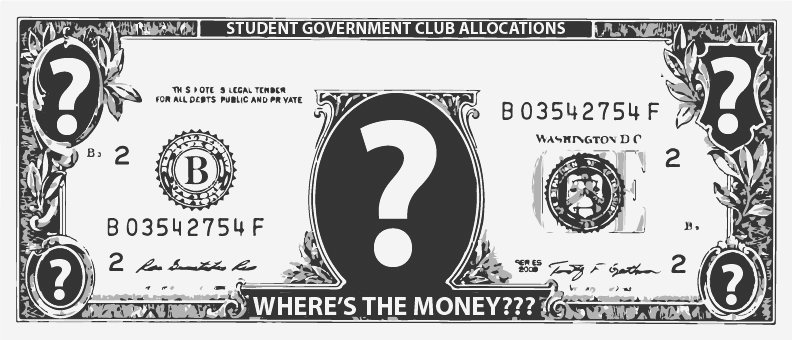
Graphic by Nick Weaver
Club Allocations Missing Dollars
Alongside money allocated by the state of North Carolina and donations, students’ tuition is an integral part of the university’s operating budget, serving to pay for things like instructor salaries, libraries and study abroad opportunities.
Warwick Arden, executive vice chancellor and provost at NC State, explained how the university receives the funds to support the academic side of the university.
“The two main sources of money that we have for supporting the academic side of the university: tuition and state appropriation, and they kind of act as offsets to one another,” Arden said.
State appropriations refers to money from the State of North Carolina to support academics. Arden estimated that about $400 million per year comes from the state, with about $100 million going towards agricultural research and the rest to other academic departments. NC State receives about $425 million in tuition and fees, which makes up about one-fifth of the university’s operating budget.
Arden explained that money from both sources is pooled together and later budgeted to each department, so it is nearly impossible to distinguish exactly how much a typical student pays for their professors and classes.
“Most faculty, and we have about 2,500 faculty, are largely on state dollars meaning a mixture of tuition and state appropriations,” Arden said.
Faculty members’ salaries depend on rank, experience and tenure, Arden explained. Additionally, tuition dollars do not just pay for classes, they also pay for other academic services.
“There are a lot of things that I think students don’t think about other than the faculty member in front of the classroom,” Arden said. “The libraries, distance-ed program, our study abroad programs, all of our global engagement, our enrollment management, our admissions office, so there is a really big infrastructure behind the delivery of instruction. It costs us about $43 million a year to run our libraries system would be an example, and that comes off the tuition side.”
Grants are the major component of funding for research projects. About $300 million a year in grants both private and federal fun research projects done by the faculty, according to Arden.
Student fees are standard to every student no matter what program they enroll in or whether they are in-state or out-of-state. The average student pays about $2500 in student fees for an academic year, according to an itemized report published by the university.
“The fee side pays for those services that students partake of whether you are an in-state, out-of-state, or an undergraduate, or a grad we make the assumption that you’re going to be accessing those services at roughly the same level so everybody pays the same fees,” Arden said. “Those are things other than the academic side, so Student Health, counseling, campus rec and transportation, all of those things.”
Vice Chancellor Mike Mullen, who is part of the board that sets student fees, explained the lengthy process of determining the yearly fees, saying it takes close to a year and a half for a fee to become a reality.
“So we’re going through that process now and we’re looking at what that means and so, if we know that its ‘X’ number of dollars that we’re going to need annually, that translates into a certain dollar fee per student based on the usual full-time equivalent of 27,000 students,” Mullen said. “That number takes into account that there’s a lot of part-time students.”
In the summer, the budget office in the students finance administration reviews the fees. In the fall, the vice chancellor works with the student senate president and the fee review committee evaluates the fee areas.
The Fee Review Committee consists of five faculty and four students. People in charge of the different fees, such as the director of Wellness and Recreation, Eric Hawkes, will talk about the reasons for a specific fee. Student Government will then review the fees in a session generally in September, Mullen said.
“The Student Senate looks at all the fees, provides their input, and what that usually amounts to is that whatever the Senate votes on the individual fees is pretty much what the Student Senate President votes on in a group of nine,” Mullen said. “It often times goes from about 7:30 to midnight or later.”
The North Carolina Government sets the prices for tuition amounts. The state covers a portion of the cost for graduate education expecting that the students will choose to live and work in North Carolina after graduation.
Arden also mentioned that the government can also influence tuition increases through Legislative Increases. The UNC-System Board of Governors and the Board of Trustees decide on tuition increases every year.
“Tuition receipts act as an offset to appropriation, so the legislator can literally come in and say ‘we’re going to increase the tuition at NC State or all universities by $1000’ and what that will do is it will decrease the amount of appropriation that the state has to give,” Arden said. “Now that will often be given during difficult budgetary times, such as when we had the last recession,”
Fees are reviewed by the chancellor, then the Board of Trustees, the Board of Governors, before the Legislature approves them, according to Mullen.
“Our goal is to keep these as low as possible,” Mullen said. “We know that because of the way we’re structured that the state fees are relatively high, but it’s always our goal to be mindful of the fact that we don’t want these to be increasing at a rapid pace all the time. It is our philosophy that we ask for fees that we need and nothing more.”
Provost Arden also mentioned that North Carolina is very supportive of higher education and that “we’ve had cuts, but we’re very well supported.” NC State is also one of the top ten best value public universities according to the US News World and Report.
More information about tuition at NC State can be found online.